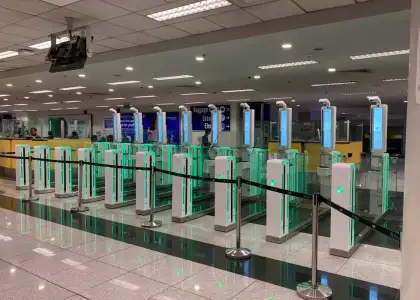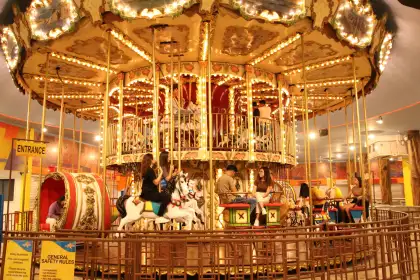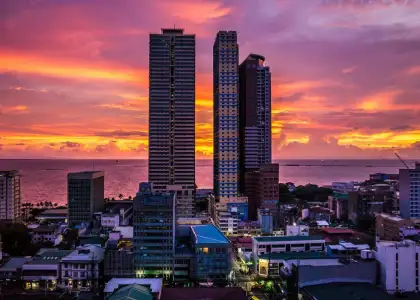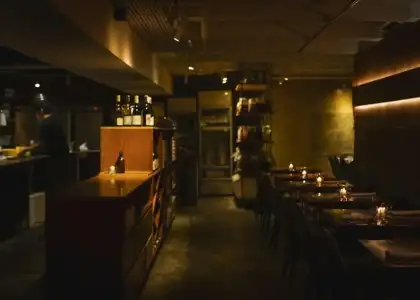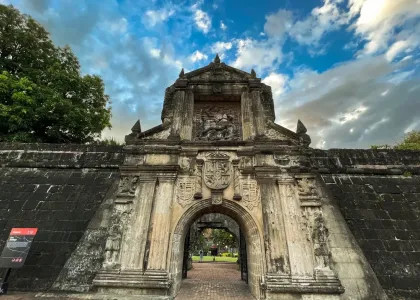One Night in Ermita: The True Horror Behind Manila's Historic District
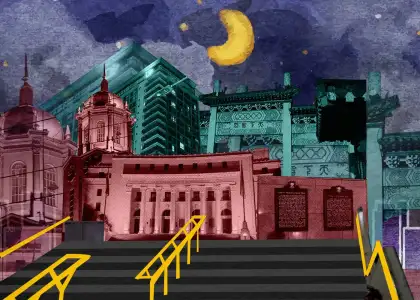
Known for being a place rich in landmarks, establishments, and historical destinations, Ermita is a district that has witnessed centuries of transformation. Here, every street corner holds a story waiting to be told — some flamboyant, some filled with secrets that bring chills to the bones.
Braving the pitch-black night sky and the dimly lit alleys of the city, The Beat Asia hopped on a tour with the goal of discovering these secrets. Helmed by our guide, Benjamin, the tour kicked off in front of the now-burned façade of the Manila Central Post Office. Compared to other places we went that night, the post office’s story was quite fresh yet somewhat devastating.

The edifice made headlines when it caught fire earlier this year for questionable reasons, inflicting minor injuries to about seven people. As the tour guide described, this incident, along with the loss of the 100-year-old architectural gem, has now become a part of the city’s dark past.
The night progressed with us striding towards the Manila Metropolitan Theater. With trembling hands and feet, we listened on to the guide’s story about the “lady in black” that haunts the venue.

The year was 1992. Teatro Pilipino staged a Filipino translation of William Shakespeare's “The Twelfth Night.” But a week before the performance, lead actress Ella Luansing Tinio died in a tragic car accident. The show still went on, and to pay tribute to Ella, another character (played by Divina Cavestany) was added: a lady in a black evening gown with her face covered with a black veil.
On its last show, Divina and the whole crew were stunned when another lady in black appeared on stage, bearing an eerie resemblance to the late Ella. This scary phenomenon was witnessed not only by the performers but also by the hundreds of audiences watching the play.
Our next venture was Arroceros Forest Park. Contrary to its green and peaceful environment, we felt that there was just something ominous about the place. As it turned out, Arroceros also witnessed some of the most brutal events in Philippine history, including a massacre. Some psychics even see visions of blood and mud in the park, or so they say.

As if these stories weren’t hair-raising enough, we continued on with the walk to Manila City Hall. On one side, the building boasts a magnificent clock tower hovering above the city, while on the other, its neoclassical architecture furnished with flickering lights hints at a harrowing history.

As told by our guide, the building was finished in 1941 with a structure that mimics a shield and was rebuilt after the Battle of Manila, which killed over 100,000 people. But because of limited space, the building now looks like a coffin. Some believe that this was intended to honor the people who passed because of the battle, while others think it’s related to the mysteries surrounding the establishment: the inauspicious coincidence of it being located in Barangay 666 or the tale of the weeping girl at the foot of the clock tower.

As we continue our journey along the streets of Ermita, walking through the well-lit sidewalk accompanied by the honks of the jeepneys and buses, our minds begin to wonder how the very concrete we’re walking on plays a significant role in the history of the city.
Upon arriving at the National Museum, we were greeted by the museum’s majestic façade, which now houses artifacts and important pieces in the history of the Philippines. But even before it became a museum, it already played an important role as the finance and agricultural office during the Battle of Manila.

Behind its majestic façade, it is also covered with dark history, just like most parts of the city. Right in the middle of the two buildings is the Agrifina Circle, derived from the offices surrounding the area. This is also the very place where the war ended. The war that claimed the lives of thousands of Filipinos and obliterated many of our most cherished cultural treasures left us with a void of knowledge and stories that are now forever beyond our reach.
Continuing with our tour, Benjamin brought us to Luneta Park, the most famous, if not one of the best-known, tourist spots in the country where our national hero, Jose Rizal, died.
In contrast to our typical visits, during which we stroll through the park and admire its beauty, we decided to delve into the park's darker history. Known as Bagumbayan in the past, this area stands in stark contrast to the joyful sounds of children's laughter that usually fill the air. Instead, it conceals a grim and inhumane chapter of history, bearing witness to tragic events such as the executions of Gomburza priests and our national hero.

As we followed our tour guide’s steps, Benjamin introduced us to yet another piece of history that is not known to everyone. Crossing through Roxas Boulevard, you can see the Bayview Hotel, which, surprisingly, is also a bear witness to the inhumane acts that happened in the middle of the war.
To add to the intrigue of our tour, our guide shared an eerie anecdote from their psychic friend. The story went that even to this day, the lingering spirits of the victims who met their fates within the hotel continue to haunt the premises, searching for untold truths.

Setting off on the tour with the anticipation of gathering paranormal tales from diverse individuals, we were unexpectedly left contemplating the hidden depths of horror that can lurk even in the city's most vibrant corners. Manila, a city that once shone with brightness, brimming with the dreams and ambitions of its residents, now stands as a bustling and perilous metropolis, with its former splendor fading into distant memory.
At this point, in the middle of the dark alley, our minds are getting clearer about what the tour is all about. It’s not about the typical scare of getting jumped on by a ghost; it’s the dark horror of the history of Manila that is truly spine-tingling for us.
This feature is done in collaboration with WanderManila, based on a tour conducted in partnership with lyf Malate Manila. To book slots for their upcoming tours around Metro Manila or get a customized tour, visit their website or inquire via email.
Get the latest curated content with The Beat Asia's newsletters. Sign up now for a weekly dose of the best stories, events, and deals delivered straight to your inbox. Don't miss out! Click here to subscribe.








